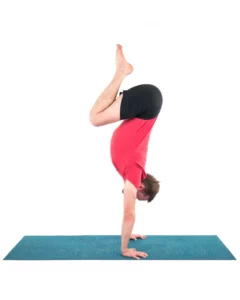Change Your Perspective of Pelvic Tilting: How the Transversus Abdominis Can Help

“Tuck your tailbone under” or “lengthen your tailbone” have long been among the most common alignment instructions in yoga. But lately, this instruction has taken a lot of flak, because the instruction can result in people flattening their lumbar curve, which, of course, is counter-productive and not the original intention of the instruction. Rather than completely abandoning this instruction and throwing the baby out with the bathwater, so to speak, let’s take a closer look at pelvic tilt, and when this instruction can be a very useful teaching tool.
Understanding the Releationship Between the Pelvis and the Spine
Most of us have a lumbar (lower back) curve and we have it for a reason. It helps to distribute the weight of the spine and other structures connected to it within the gravitational pull. Some of us have more pronounced lumbar curves, and some less pronounced. The degree of the curve reflects how much your pelvis is tilted forward.
Try this:
- Stand tall and place your hands on your hips. Imagine you are holding a bucket of water.
- On the inhalation tip the pelvis forward as if to spill the water in front of you, notice how far it goes.
- On the exhalation tip the pelvis backward as if to spill the water behind you.
What you are doing here is assessing the degree of the anterior (forward) and posterior (backward) pelvic tilt. The range of movement here will differ from person to person. So you will end up somewhere on the spectrum between the tin man (stability) and a noodle (mobility). And just like in most other body areas the extremes of that spectrum are not preferable. You need to be both stable and mobile.
When we talk about developing and maintaining a healthy relationship between the pelvis and the spine, there are two main ways to approach it: the pelvic tilt and the corset.
Practicing Safe Yoga: The Pelvic Tilt
 The pelvic tilt means using progressive abdominal contraction to tip the top of the pelvis backward, which will result in the tailbone tucking under. We usually use the pelvic tilt to bring student’s awareness to the position of her pelvis, as well as develop and maintain mobility in the lumbar spine. It can be done in a supine position, in kneeling or standing.
The pelvic tilt means using progressive abdominal contraction to tip the top of the pelvis backward, which will result in the tailbone tucking under. We usually use the pelvic tilt to bring student’s awareness to the position of her pelvis, as well as develop and maintain mobility in the lumbar spine. It can be done in a supine position, in kneeling or standing.
For example, in a supine position:
- Lie on your back with knees bent.
- On the exhalation pull the navel in toward the spine. The natural result of that will be a posterior pelvic tilt and the tailbone will tuck under.
This kind of exploration can do the following:
- Increase your general awareness of the movement of the pelvis.
- Teach you to move the pelvis by contracting the abdomen, not the glutes (butt muscles).
- Demonstrate the relationship between the muscles of the abdomen and muscles of the back. (When the abdomen is contracting, the lower back is stretching and vice versa.)
- Give you a chance to practice progressive abdominal contraction on the exhalation.
These are all worthy goals and can significantly increase your body awareness.
More Options for Practicing Pelvic Tilt
Or in a kneeling position: When you do a Cat-Cow movement (Marjaryasana/Bitilasana) and round your back on exhalation, once again you are pulling the belly button in toward the spine. This will result in your tailbone tucking under. Your goal here is to alternate contracting and stretching of the lower back muscles. So this kind of spinal flexion is fine, as long as you focus on lifting the chest on the inhalation (rather then overarching the lower back) and progressive abdominal contraction on the exhalation (rather then tensing the glutes). This feels good to most students and helps them to warm up their backs. 
Or in a standing position: When you are doing Warrior I Pose (Virabhadrasana I), for example, progressively contract your abdomen and tuck the tailbone slightly. This will help you become more aware of the relationship between your pelvis, your abdomen and your spine, as well as get a better stretch in the hip flexors.
These are the examples of when tucking the tailbone under is a natural result of a progressive abdominal contraction that initiates a posterior pelvic tilt. It makes sense then to direct your student’s attention to the gradual abdominal contraction rather then the tailbone tucking, even though those two go hand in hand. This can be an excellent teaching tool to build student’s awareness about the relationship between the pelvis and the spine.
 Practicing Safe Yoga: The Corset
Practicing Safe Yoga: The Corset
The corset, on the other hand, means hugging the waist in toward the center as if you were tightening an invisible corset around your torso. It is a similar action of progressive abdominal contraction, but here no visible change occurs in the position of your pelvis and the lower back remains neutral. This is a preferable method for creating and maintaining stability in your core and is useful in any yoga posture. So if you are in Half Chair Pose (Ardha Utkatasana), for example, instead of tucking the tailbone under you would want to focus on hugging the waist in all around. This helps you maintain your natural lower back curve and create support for your lumbar spine.
Quite often the tucking of the tailbone is done with the idea of correcting the excessive lower back curve, either in a yoga posture or simply in a standing or seated position. This is understandable, but then we are running the risk of overcorrecting and flattening the lumbar curve altogether. This kind of thinking (“My pelvis tips forward a lot, so I will just tip it back to realign it”) is reflective of a very mechanistic approach to body alignment and often leads to replacing one dysfunction with another.
In a situation like this your body is much better served by learning the corset action which will help create more stability in the core. I turn, it will help your pelvis land where it needs to go. We have a lumbar curve for a reason, we don’t want to lose it. Instead we want to support it. The support comes from the conscious “corset” action, which also helps to position your pelvis in its proper location.
Pelvic Tilt Awareness
To sum it up: if your goal is to increase awareness of the progressive abdominal contraction and create more mobility in your lumbar spine, pelvic tilts work great for that. It is usually a great first step in preparation for the corset, which is more effective for creating stability and support, but can be difficult for newcomers to grasp and feel. Once the students grasp the idea of progressive abdominal contraction, it is a good idea to make a habit out of engaging the abdomen with every exhalation when you practice.
Step 1 – Creating awareness of the abdominal contraction with the pelvic tilt
Step 2 – Creating awareness of the abdominal contraction without the tilt
Step 3 – Using abdominal contraction with every exhalation during practice (with or without the tilt depending on the posture).
Also, read...
Cat-Cow Pose (Marjaryasana-Bitilasana)
2 Restorative Yoga Poses to Calm Your Body and Mind
Related courses

Educated as a school teacher, Olga Kabel has been teaching yoga for over 14 years. She completed multiple Yoga Teacher Training Programs but discovered the strongest connection to the Krishnamacharya/ T.K.V. Desikachar lineage. She had studied with Gary Kraftsow and American Viniyoga Institute (2004-2006) and received her Viniyoga Teacher diploma in July 2006, becoming an AVI-certified Yoga Therapist in April 2011. Olga is a founder and managing director of Sequence Wiz— a web-based yoga sequence builder that assists yoga teachers and yoga therapists in creating and organizing yoga practices. It also features simple, informational articles on how to sequence yoga practices for maximum effectiveness. Olga strongly believes in the healing power of this ancient discipline on every level: physical, psychological, and spiritual. She strives to make yoga practices accessible to students of any age, physical ability, and medical history, specializing in helping her students relieve muscle aches and pains, manage stress and anxiety, and develop mental focus.



